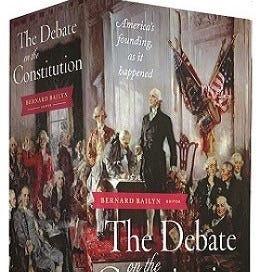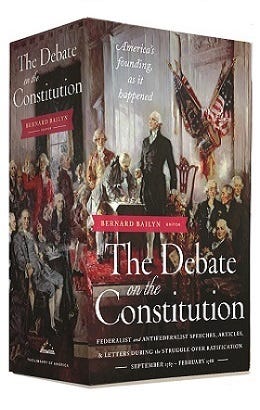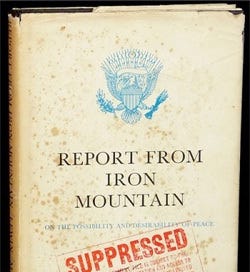

Discover more from Frederick R. Smith Speaks
The Debate on the Constitution
Despite the Caustic Cancel Culture Pogrom’s efforts to erase our history, a plethora of exquisite documents about our founding abounds.
Foreword
First, a belated Happy Birthday to the United States Constitution (September 17, 1787).
As an “Armchair Historian,” your author has a fondness for our Founding. Despite the Caustic Cancel Culture Pogrom efforts to erase our history, a plethora of exquisite documents abound. It is a marvel to think about the vast number of records that started with cursive handwritten works penned onto parchment. Later, it took a vast amount of manual labor to transform the parchment writing into typeset documents. Today, the California Job Case and the typesetting craft are forgotten relics of the past.
After the Constitutional Convention (May 25 – September 17, 1787), a series of written works appeared between November 1787 and April 1788 that debated the merits of the newly crafted national framework. Known as the Federalist and Antifederalist Papers, the proponents (Federalists) won the debate on June 21, 1788. On this date, the Constitution became legal in New Hampshire, the ninth state to vote in favor of ratification. The papers in book form known as the Debate on the Constitution (2,389 pages), along with James Madison’s Writings (966 pages) have an honored place of display in the Frederick R. Smith library.
Federalist Papers
The Federalist Papers, or simply The Federalist, was a series of essays to show that the new Constitution (September 17, 1787) was the only way to ensure a Union. While staying silent about their doubts and disappointments, James Madison 1 and Alexander Hamilton, 2 joined by John Jay, 3 undertook this series of papers to explain the merits of the new Constitution. They also answered objections to the Constitution that had already appeared in newspaper columns in New York and elsewhere across the nation. The Federalists showed that the framework held intrinsic constitutionalism more than any other speech or writing defending the new plan for the Union. Furthermore, these writings gave a purpose to the entire text of the Constitution and each of its components.
The name given to the author of each of the 85 essays was “Publius,” the pseudonym chosen by the then anonymous authors. The Federalist appeared in New York newspapers beginning on October 27, 1787, addressed “To the People of the State of New York.” This greeting reflected that the New York state legislature had made an authoritative order having the force of law concerning universal male suffrage for the election to the state ratifying convention while voting for state offices had property qualifications attached. The First essay joined in a debate already in progress as Hamilton had himself published two letters in July and September attacking Governor George Clinton (leader of the state’s Antifederalists). At the height of the series, three or four new essays by Publius appeared every week until the last paper published on May 28, 1788 (No. 85).
Essays by the Antifederalists began appearing on September 27, 1787. Disappointed with his letters and impressed with the new Antifederalist writings, Hamilton launched the new, extensive series of essays under Publius.
Hamilton chose “Publius” to counter his adversaries’ use of the heroes of the late Roman republic—Brutus and Cato. Publius Valerius Publicola’s biography is like the personality of Solon in “Parallel Lives,” written by Plutarch (46 to 120 AD), the Greek biographer. Solon, the democratic lawgiver of Athens, had lived to see his majority overthrown by a tyrant. Solon had left Athens for ten years to avoid having to interpret his legislation. On the other hand, Publius firmly set up his republic, which endured and expanded for centuries. Publius had remained in Rome to serve as consul (504, 507 – 509 BC) to improve the city’s primitive republican laws and to impart his spirit of moderation, justice, and wisdom to the regime. The Roman people had honored Publius with the name “Publicola” which means a cherisher or lover of the people.
It has been challenging to figure out who wrote several of the Federalist papers, particularly Nos. 49-57 and Nos. 62-63 (view here). Many methods have been employed, including computer analysis, but scholars continue to debate this issue.
Antifederalist Papers
The Constitution’s opponents (defenders of the Articles of Confederation) rallied against the much stronger central government offered in the new framework. Ironically, they thought of themselves as the “Federalists” as they were advocates of a loose confederation. They believed that supporters of the Constitution were pushing for a too strong centralized government. In a linguistic coup, Hamilton used the Federalist title first, placing the opponents in political limbo. Consequently, history only knows them as the Antifederalists or “Grumbletonians.”
Essays by the Antifederalist writer “Cato” began appearing on September 27, 1787. That was followed by the first of the powerful Antifederalist “Brutus” papers on October 18, 1787.
With Federalists winning the argument, the nation flourished for her first 200 years. 4 In the subsequent years, the Antifederalists’ warnings about an out-of-control government have come true. As detailed in the Antifederalist Papers, we see that The Antifederalists Were Eerily Prophetic: 5
Antifederalists opposed the Constitution on the grounds that its checks on federal power would be undermined by expansive interpretations of promoting the “general welfare” (which would be claimed for every law) and the “all laws necessary and proper” clause (which would be used to override limits on delegated federal powers) creating a federal government with unwarranted and undelegated powers that were bound to be abused.
Also, see Frederick R. Smith’s post titled Festering Federal Courts.
Federalist Alexander Hamilton encouraged credit-style banking and promoted expansive government. That may explain why there is such a WOKE 6 infatuation with the Broadway Musical “Hamilton.”
The debased folk love a big government to get freebies. Well, sports fans, wait and see how expensive things become when everything is “free.”
Cogent author and publisher, Frederick R. Smith
James Madison (1751-1836), fourth President of the United States (1809-1817). A member of the Continental Congress (1780-1783) and the Constitutional Convention (1787), he strongly supported the ratification of the Constitution. His presidency was marked by the War of 1812.
Alexander Hamilton (1755-1804), as the first U.S. secretary of the treasury (1789-1795), established the national bank and public credit system. Hamilton died in a duel with his political rival, then vice-president Aaron Burr.
John Jay (1745-1829) was an American diplomat and jurist who served in both Continental Congresses and helped negotiate peace with Great Britain (1782-1783). He was the first chief justice of the Supreme Court (1789-1795) and arranged a second agreement with Great Britain, Jay’s Treaty (1794-1795).
The gut punch to the nation that started the bleeding occurred in 1913 with direct taxation of wages (16th Amendment), direct election of senators (17th Amendment), and the Federal Reserve Act
Foundation for Economic Education at https://fee.org/articles/the-antifederalists-were-eerily-prophetic/
Willfully Ordering the Killing of Entrepreneurship
Subscribe to Frederick R. Smith Speaks
The Frederick R. Smith blog is the ramblings of an uncommon man in a post-modern world. As a master of few topics, your author desires to give readers a sense of the thoughts of a senior citizen who lived most of his life before the new normal.













The authors of the Federalist Papers, including Alexander Hamilton, James Madison, and John Jay, chose to write under pen names. They used the collective pseudonym "Publius." The decision to remain anonymous served several important purposes during the late 18th century.
Personal attacks were likely during a time of political polarization and regional differences. Using pen names avoided ad hominem arguments. By writing this method, they shielded themselves from personal attacks. This protected the substance of their arguments. This strategy allowed the Federalist Papers to maintain a higher level of intellectual discourse.
Anonymity also encouraged a wider readership. People were more likely to engage with the Federalist Papers. They didn't have preconceived biases based on the authors' previous positions or affiliations. This helped the papers reach a diverse audience. It facilitated a more open-minded consideration of the ideas presented.
Using pen names allowed the authors to adapt their arguments to changing circumstances. If one of the authors changed their position on a particular issue, it wouldn't be immediately clear. The collective identity of Publius could remain consistent.